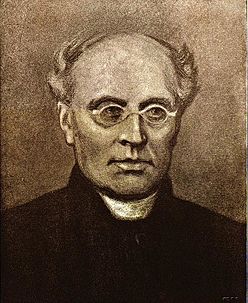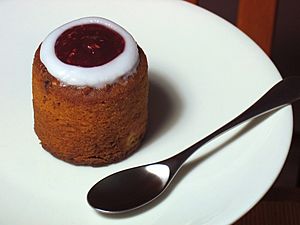Johan Ludvig Runeberg facts for kids
Quick facts for kids
Johan Ludvig Runeberg
|
|
|---|---|

Johan Ludvig Runeberg (portrait by C. P. Mazer)
|
|
| Born | 5 February 1804 Jakobstad, Ostrobothnia, Swedish-ruled Finland
|
| Died | 6 May 1877 (aged 73) |
| Spouse(s) | Fredrika Tengström |
| Children | 8, including Walter Runeberg |
| Signature | |
Johan Ludvig Runeberg (born February 5, 1804 – died May 6, 1877) was a famous Finnish poet and priest. He is known as the national poet of Finland. He wrote all his poems in Swedish. Runeberg wrote the words for Vårt land (Our Land), which became Finland's national anthem. He also helped update the Finnish Lutheran hymnal, writing many new songs for it.

Contents
Early Life and Learning
Growing Up in Finland
Johan Ludvig Runeberg was born in Jakobstad, Finland. This town is right by the sea, on the shores of the Gulf of Bothnia. His family spoke Swedish. His father, Lorentz Ulrik Runeberg, was a sea captain. His mother was Anna Maria Malm. Johan's grandfather had moved to Finland from Sweden. His mother's family were merchants from Jakobstad, also with roots in Sweden.
When Johan was a child, he had an illness called scrofula. This caused swelling in his glands. Because of this illness, he grew more slowly than other children. He did not learn to walk until he was three or four years old. Johan got his strong and lively personality from his father. From his mother, he inherited his sensitive and artistic side.
School Days and Studies
At eight years old, Runeberg went to live with his uncle in Oulu to go to school. He later studied in the city of Vaasa. After that, he attended the Imperial Academy of Turku. There, he became good friends with Johan Vilhelm Snellman and Zacharias Topelius.
Runeberg mostly studied old languages like Latin and Greek. He earned a Master of Philosophy degree in 1827. He worked as a private teacher from 1822 to 1826. Later, he became a teacher at the Swedish-language Helsingfors Lyceum. In 1837, he moved to Porvoo. There, he taught Latin literature at the Borgå gymnasium. Runeberg also supported a school for deaf children in Porvoo. He even served on its school board.
Famous Poems
Many of Runeberg's poems describe life in the Finnish countryside. One of his most famous poems is Bonden Paavo, or Farmer Paavo. This poem is about a poor farmer in Saarijärvi. It shows his strong will, called sisu in Finnish, and his deep faith.
The Story of Farmer Paavo
In the poem, a cold night destroys Farmer Paavo's crops three times. Each time, he mixes more bark into his bark bread to avoid starvation. He works even harder to turn wet marshland into dry land. This new land would be less likely to freeze.
After the fourth year, Paavo finally gets a great harvest. His wife is very happy and thanks God. She tells Paavo they can now eat bread made only from grain. But Paavo tells her to mix bark into the grain one more time. Their neighbor's crops were lost in a frost, so Paavo gives half of his harvest to the needy neighbor.
Important Works
Runeberg wrote many important poems. One was the idealist poem "Älgskyttarna" (Elk Hunters) in 1832. Another was the epic poem Kung Fjalar (King Fjalar) in 1844.
The Tales of Ensign Stål
His most famous work is Fänrik Ståls Sägner (The Tales of Ensign Stål). He wrote this heroic poem between 1848 and 1860. It is considered one of the greatest Finnish epic poems. It tells stories from the Finnish War of 1808–09. In this war, Sweden lost Finland to Russia. Finland then became a Grand Duchy under the Russian Empire.
The poem is made up of many short stories. It shows the common humanity of everyone involved in the war. But it mainly praises the bravery of the Finns. The very first poem in this collection, Vårt land (Our Land), became the Finnish National Anthem.
Family Life
Johan Ludvig Runeberg married his second cousin, Fredrika Runeberg. She was also a writer, creating poems and novels. They had eight children together. Their oldest son was the famous sculptor Walter Runeberg. Johan also had several emotional relationships during his life. These included relationships with Maria Prytz and the younger poet Emilie Björkstén.
Lasting Impact
People celebrate Runeberg Day in Finland every year on February 5. This is the day Runeberg was born. A special pastry called a Runeberg torte is very popular around this time. It is flavored with almonds and is usually sold from early January until February 5.
There is a statue of Johan Ludvig Runeberg in Helsinki. It is located on Esplanadi and was made by his son, Walter Runeberg. A place in Becker County, Minnesota called Runeberg Township is also named after him. The Runeberginkatu street in central Helsinki is named in his honor too.
In 2004, Finland created a special €10 coin to celebrate Runeberg's 200th birthday. The coin shows a picture of Runeberg's face. The back of the coin features an old font sample from a Swedish newspaper. This is because Runeberg wrote most of his works in Swedish.
See also
 In Spanish: Johan Ludvig Runeberg para niños
In Spanish: Johan Ludvig Runeberg para niños
- List of Swedish-language writers
- MS J. L. Runeberg
- Project Runeberg
- Runeberg Prize
- Runeberg torte
- Sven Dufva


